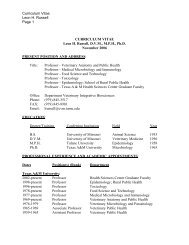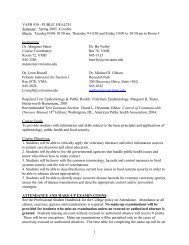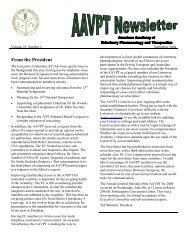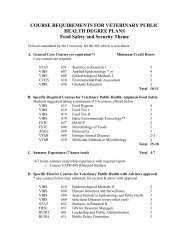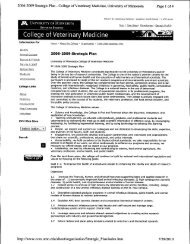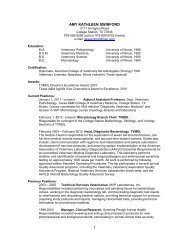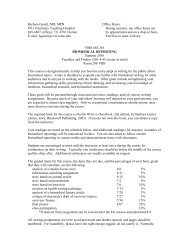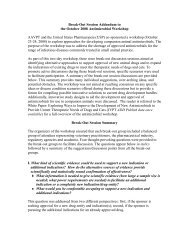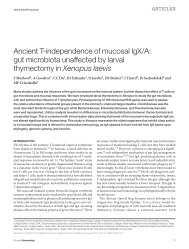Download PDF - College of Veterinary Medicine - Texas A&M ...
Download PDF - College of Veterinary Medicine - Texas A&M ...
Download PDF - College of Veterinary Medicine - Texas A&M ...
Create successful ePaper yourself
Turn your PDF publications into a flip-book with our unique Google optimized e-Paper software.
Faculty/Staff Focus<br />
Janecka works to save the ocelot population in <strong>Texas</strong><br />
The ocelot (Leopardus pardalis), native<br />
to <strong>Texas</strong>, Mexico, Central America,<br />
and South America, is similar in<br />
appearance to a domestic cat but is<br />
slightly larger and has a beautiful coat<br />
resembling that <strong>of</strong> the leopard or jaguar.<br />
During the 20th century, people<br />
precipitated the ocelot’s decline in<br />
<strong>Texas</strong> by colonizing and removing their<br />
dense thorn-shrub habitat and taking<br />
advantage <strong>of</strong> their unique coat in the<br />
fur trade. This led to eradication <strong>of</strong><br />
ocelots in many areas where they were<br />
once common. Without conservation<br />
efforts, the ocelot may become extinct<br />
in its native <strong>Texas</strong> habitat.<br />
Dr. Jan Janecka, a research assistant<br />
pr<strong>of</strong>essor at the <strong>Texas</strong> A&M <strong>College</strong><br />
<strong>of</strong> <strong>Veterinary</strong> <strong>Medicine</strong> & Biomedical<br />
Sciences (CVM) and strong supporter<br />
<strong>of</strong> conservation efforts for many exotic<br />
cats, recently published a paper with<br />
the help <strong>of</strong> other researchers and scientists<br />
to understand the genetic diversity<br />
<strong>of</strong> ocelots and the reasons for their<br />
slow disappearance from <strong>Texas</strong>. The<br />
project generated a wealth <strong>of</strong> knowledge<br />
on the <strong>Texas</strong> ocelot population<br />
that will be incorporated into conservation<br />
initiatives designed to help species<br />
recovery and lead to eventual ocelot<br />
population growth in their native<br />
environment.<br />
54 • CVM Today • Winter 2012<br />
Dr. Jan Janecka<br />
“There are only two ocelot populations<br />
left in <strong>Texas</strong>,” Janecka said.<br />
“Over-harvest <strong>of</strong> the species and<br />
removal <strong>of</strong> habitat in the 1900s led to<br />
major population reductions. Today,<br />
ocelots in <strong>Texas</strong> are restricted to the<br />
Lower Rio Grande Valley, and less than<br />
80 remain between the two different<br />
populations, although there may be a<br />
few additional cats in nearby areas.”<br />
Janecka added, “Ocelots prefer a<br />
dense brush habitat, and they cannot<br />
move through large open land separating<br />
brush patches because <strong>of</strong> their shy<br />
nature. Dr. Michael Tewes, [coordinator<br />
<strong>of</strong> the Feline Research Center<br />
and regents pr<strong>of</strong>essor at the Caesar<br />
Kleberg Wildlife Research Institute<br />
at <strong>Texas</strong> A&M University–Kingsville],<br />
and his students and colleagues have<br />
radio-collared ocelots for over 30 years<br />
to understand their ecology, behavior,<br />
and dispersal patterns. Over this<br />
period, there has not been a single<br />
observed successful migration between<br />
the two populations in <strong>Texas</strong>. This is<br />
consistent with the genetic data that<br />
revealed complete isolation <strong>of</strong> these<br />
areas. This complete isolation results in<br />
genetic erosion and inbreeding depression<br />
that compromises persistence <strong>of</strong><br />
the ocelots.”<br />
Janecka’s research was the result <strong>of</strong><br />
several collaborations between different<br />
institutions including <strong>Texas</strong> A&M<br />
University (Janecka, Rodney Honeycutt,<br />
William Murphy, and Brian Davis),<br />
Caesar Kleberg Wildlife Research Institute,<br />
<strong>Texas</strong> A&M University–Kingsville<br />
(Mike Tewes, Janecka, Aaron Haines,<br />
Arturo Caso, and David Shindle),<br />
and the US Fish and Wildlife Service<br />
(Linda Laack).<br />
The small population size, the inability<br />
<strong>of</strong> ocelots to move through the<br />
fragmented habitat, and loss <strong>of</strong> genetic<br />
diversity in <strong>Texas</strong> all indicate that an<br />
initiative to help save the ocelots from<br />
extinction in <strong>Texas</strong> is imperative.<br />
The major players most important<br />
for ocelot conservation are the landowners<br />
whose ranches are capable <strong>of</strong><br />
supporting ocelot populations.<br />
“I have formed a group <strong>of</strong> ranchers who are<br />
interested in learning about ocelot ecology or<br />
surveying for ocelots on their property. The key<br />
to ocelot recovery will be private landowners who<br />
own most <strong>of</strong> the land occupied by ocelots.“<br />
~Dr. Michael Tewes<br />
“Credibility is the key to working<br />
with the ranchers and landowners<br />
<strong>of</strong> south <strong>Texas</strong>,” Tewes said. “I have<br />
spent over 30 years cultivating dozens<br />
<strong>of</strong> relationships with these critical<br />
landowners, and they realize that I am<br />
able to maintain confidentiality with<br />
them and the role they play for ocelot<br />
management.”<br />
“Jan and his lab team work with Dr.<br />
Randy DeYoung, [assistant pr<strong>of</strong>essor<br />
and research scientist with the Feline<br />
Research Center at the Caesar Kleberg<br />
Wildlife Research Institute at <strong>Texas</strong><br />
A&M University–Kingsville], and our<br />
molecular genetics lab to produce<br />
cutting-edge results and information<br />
critical in planning ocelot recovery,”<br />
Tewes said. “We also provide the<br />
field research on ocelots and interface<br />
with the various ranchers, while<br />
Jan contributes the key analyses and<br />
interpretations <strong>of</strong> data that identify the<br />
directions we need to pursue in ocelot<br />
management.”<br />
The research team is developing<br />
partnerships with government agencies<br />
including <strong>Texas</strong> Parks and Wildlife and<br />
the U.S. Fish and Wildlife Service to<br />
provide incentives for landowners to<br />
support conservation efforts. The team<br />
is also working closely with ranches to<br />
continued on page 55




